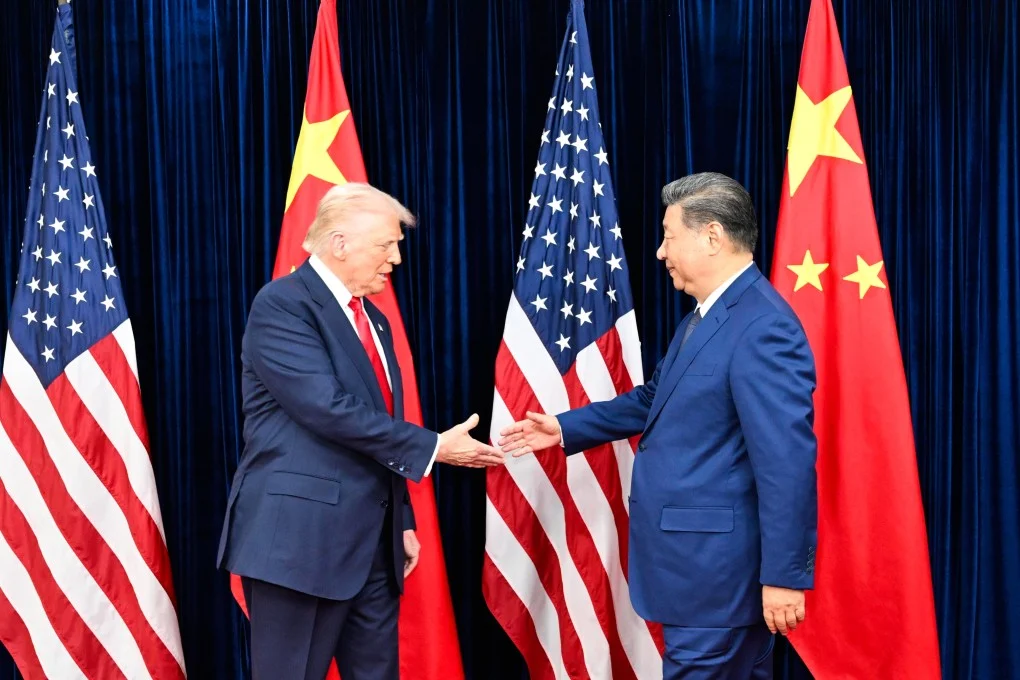Fragile Peace in Progress as U.S.–China Trade Truce Gains Momentum
Fragile Peace in Progress as U.S.–China Trade Truce Gains Momentum
By
Junia Wells
Last updated:
November 12, 2025
First Published:
November 12, 2025

Photo: South China Morning Post
The long and turbulent trade battle between the United States and China appears to be entering a new, uneasy chapter. A series of measures agreed upon in last month’s trade accord officially took effect on Monday, signaling a temporary cooling in one of the world’s most consequential economic rivalries.
While the initial steps reflect progress toward easing trade tensions, analysts caution that the détente remains precarious. Both nations continue to maneuver strategically, keeping critical leverage points intact even as they showcase cooperation.
Key Provisions of the New Trade Agreement
The latest agreement, negotiated between U.S. President Donald Trump and Chinese President Xi Jinping, includes mutual tariff reductions and adjustments to export restrictions that had strained global supply chains for over two years.
The U.S. has cut tariffs on certain imports from China to 10%, down from 20%, and extended the reciprocal tariff truce—lowering China’s rates from 34% to 10% for another year. In exchange, Beijing’s Ministry of Commerce rolled back export restrictions on several critical minerals and rare earth materials, which are essential for semiconductors, defense manufacturing, and clean-energy technologies.
These export controls, first introduced in October 2024, targeted U.S. access to materials like gallium, germanium, antimony, and synthetic diamonds — all of which play key roles in electronics, aerospace, and energy industries. By lifting these curbs, China aims to ease friction while keeping some strategic tools in reserve.
Beijing’s Strategic Balancing Act
Despite these conciliatory moves, China has stopped short of dismantling the export-control framework it launched in April 2024. Economists at Morgan Stanley suggest Beijing’s restraint is intentional — a “calibrated choke point” strategy designed to preserve bargaining power in future negotiations.
Meanwhile, reports indicate that China is developing a new “validated end-user” (VEU) system to monitor the final destinations of its rare earth exports. According to insiders, the VEU mechanism could restrict the sale of critical minerals to firms with links to the U.S. military, potentially complicating procurement for companies in the automotive and aerospace sectors with dual civilian and defense operations.
The system, if strictly enforced, would add another layer of complexity to already strained supply chains, particularly as Western nations work to diversify sources for rare earths and battery materials.
Expanding the Scope of Cooperation
In a surprising twist, China also announced on Monday that it added 13 new fentanyl precursors to its export control list, requiring special licenses for shipments to the U.S., Mexico, and Canada. The move is widely seen as an olive branch amid ongoing diplomatic discussions on synthetic drug trafficking.
Additionally, Beijing suspended sanctions for one year against five U.S.-linked subsidiaries of South Korean shipbuilder Hanwha Ocean, a gesture aimed at stabilizing cross-border industrial relations. The Ministry of Transport also paused tariffs and port fees targeting U.S. shipping operations, while the U.S. Trade Representative’s Office reciprocated by freezing its own punitive measures for the same period.
A Cautious Thaw Amid Strategic Rivalry
Experts say the tone of this latest deal reflects a tactical reset rather than a genuine resolution. “These steps suggest ‘so far, so good,’ but in reality, this is just the beginning,” remarked Wendy Cutler, Senior Vice President at the Asia Society Policy Institute, noting that both sides remain wary of overcommitting.
The détente may cool trade friction for now, but the underlying technological and geopolitical rivalry—from semiconductor supremacy to defense-linked supply chains—remains unresolved. The ongoing negotiations, analysts predict, will likely evolve into a pattern of rolling agreements, temporary truces, and periodic flare-ups as both economies balance interdependence with competition.
Outlook: Temporary Calm Before the Next Phase
While global markets have welcomed the news—sending Asian and European equities slightly higher—the sense among policy analysts is clear: this is a fragile peace, not a lasting settlement.
The U.S.–China relationship continues to be defined by strategic caution and economic pragmatism, with each side leveraging trade, technology, and resources to strengthen its geopolitical footing. As these measured rollbacks take effect, the world’s two largest economies may have hit “pause” on escalation—but neither seems ready to press “stop.”
Popular articles
Subscribe to unlock premium content
The Rise of Silent Walking Tours in Historic Cities

The Rise of Ultra-Niche Cooking Classes Focused on Historical or Regional Recipes

The Rise of One-Person Dining Experiences for Ultra-Introverts in Major Cities

The Rise of Silent Walking Tours in Historic Cities

The Rise of Ultra-Niche Cooking Classes Focused on Historical or Regional Recipes

The Rise of Silent Walking Tours in Historic Cities









